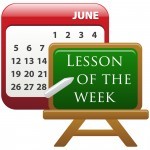Online Lesson: Tyler McAdams- Keys to Stop Lifting in the Backswing
By Wayne | Videos: Online Students

Tyler only had a down the line view for me to analyze but he wanted to see what I said anyway, so I gave it a shot. My suggestions here are to stand up taller at address with more weight toward the balls of the feet and less knee flex to feel like he would want to create space for the right arm in transition, which means he wouldn’t be losing angle in the mid-section as he moves from P2 to P4. Instead, he could try to create more hip flexion (mostly concentrating on the right hip, which would take the left hip with it) once the swing gets started and especially as he gets to the top of the swing. Also, I suggest that he try to open the face a bit more with forearm rotation almost immediately after the club starts moving so that the right arm might stay in front of him and take some of the stress out of his upper trunk turn. The feeling of adding hip flexion and tilting the pelvis more downward (anterior tilt) while changing direction against the brace of the right foot and leg should cause his head to lower a bit more as he starts down.
Continue reading



